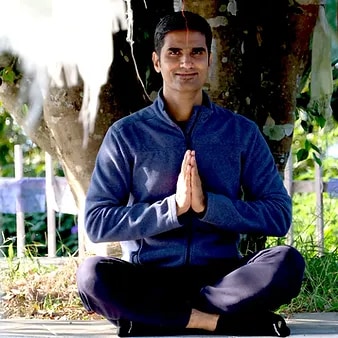The Art of Ahimsa
by Hardik Mehta

Cultivating Non-Violence in Everyday Life through Ashtanga Yoga
In the sacred tapestry of Ashtanga Yoga, the first Yama, or ethical principle, stands as a foundational pillar—Ahimsa, the practice of non-violence. Originating from the ancient wisdom of Sage Patanjali’s Ashtanga Yoga, Ahimsa extends beyond mere physical non-violence, encompassing thoughts, words, and actions in a holistic embrace. In this exploration, we will delve into the profound philosophy of Ahimsa, unravel its layers, and understand how to integrate it seamlessly into the fabric of our daily lives.
Understanding Ahimsa
Ahimsa encourages us to cultivate a consciousness of non-harm towards all living beings, including ourselves. This principle recognizes the interconnectedness of all life and underscores the importance of fostering a compassionate and empathetic mindset. Ahimsa challenges us to reassess our relationships—with others, with nature, and with ourselves—and to transform any tendencies towards aggression, hatred, or indifference.
Practicing Ahimsa in Thought
Ahimsa begins with the mind. The thoughts we harbour shape our reality, and embracing non-violence at the mental level involves cultivating awareness and mindfulness. Through meditation and introspection, we can observe our thought patterns, identifying and gradually replacing harmful thoughts with ones that promote understanding, empathy, and kindness.
Mindful communication is also an integral aspect of mental Ahimsa. Choosing words that uplift rather than degrade, practicing active listening, and abstaining from gossip contribute to creating an atmosphere of non-violence in our interpersonal interactions.
Ahimsa in Speech
Words possess immense power—they can either wound or heal. The practice of Ahimsa in speech involves choosing our words wisely and speaking with sincerity and compassion. Verbal non-violence extends beyond refraining from harsh language; it encompasses abstaining from lies, manipulation, and any form of communication that may cause harm.
In daily life, one can practice Ahimsa in speech by cultivating a habit of speaking truthfully, avoiding gossip and slander, and expressing oneself in a manner that promotes harmony rather than discord. Mindful communication becomes a tool for building understanding and fostering positive relationships.
Ahimsa in Action
The physical manifestation of Ahimsa involves acting in ways that do not cause harm to oneself or others. This principle challenges us to reassess our behaviours and make choices that align with the values of non-violence.
In a practical sense, this could mean adopting a vegetarian or plant-based diet to minimize harm to animals, supporting eco-friendly practices to preserve the environment, and avoiding actions that contribute to social injustices. Ahimsa calls for conscious consumerism, encouraging us to be aware of the impact our choices have on the well-being of others and the planet.
Inner Transformation
Yoga is a path of self-realization and inner transformation. Ahimsa encourages individuals to examine their thoughts, speech, and actions, fostering a deeper understanding of oneself and promoting personal growth.
Self-Compassion and Ahimsa
Ahimsa extends inward, urging us to treat ourselves with the same compassion and kindness that we extend to others. Self-criticism, perfectionism, and negative self-talk are forms of self-violence that Ahimsa invites us to transcend. Through self-awareness and self-love, we can break free from destructive habits and foster a nurturing relationship with ourselves.
The Practice of Ahimsa on the Yoga Mat
Ashtanga Yoga is not merely a physical practice; it is a holistic system that integrates mind, body, and spirit. The practice of Ahimsa on the yoga mat involves respecting and honouring the body’s limitations, avoiding self-judgment, and approaching the practice with a sense of curiosity and acceptance.
Incorporating Ahimsa into asana practice means cultivating mindfulness, listening to the body’s signals, and refraining from pushing it beyond its natural capacity. Yoga becomes a tool for self-discovery and healing rather than a battleground where one competes with oneself or others.
Cultivating Ahimsa Off the Mat
The true test of Ahimsa lies in its seamless integration into everyday life. Small, intentional acts of kindness and compassion contribute to the creation of a more harmonious world. Holding the door for someone, offering a kind word, or practicing patience in traffic are simple yet powerful expressions of non-violence.
Ahimsa also involves standing up against injustice and oppression. Whether it be advocating for human rights, environmental conservation, or social equality, the practice of non-violence extends beyond personal interactions to encompass a broader commitment to the well-being of the global community.
Challenges on the Path of Ahimsa
Practicing Ahimsa is not always easy. It requires a deep commitment to self-awareness and a willingness to confront and transform deeply ingrained patterns of thought and behaviour. As we navigate the complexities of modern life, we may encounter situations that challenge our commitment to non-violence.
In moments of conflict or stress, cultivating a pause—whether through deep breaths, meditation, or a brief reflection—can create space for a conscious response rather than a reactive one. This mindful approach allows us to navigate challenges with greater equanimity and resilience.
Ahimsa, as the first Yama in Ashtanga Yoga, serves as a guiding light on the path of self-discovery and transformation. It challenges us to examine the impact of our thoughts, words, and actions on ourselves, others, and the world at large. Through the consistent practice of Ahimsa, we contribute to the creation of a more compassionate and interconnected world—one where non-violence becomes a way of life, both on and off the yoga mat. As we navigate the intricate dance of existence, let us embrace the profound wisdom of Ahimsa and allow it to permeate every facet of our being, fostering a world where love and understanding prevail.
About the Author

Hardik Mehta
Hardik is an E-RYT 500 & YACEP (Yoga Alliance Continuing Education Provider), Yoga Alliance, USA. He has been practicing yoga for the last 9 years. Prior to finding his true calling in Yoga, he was working with various corporates for 12 years in the Retail and eCommerce sector.
